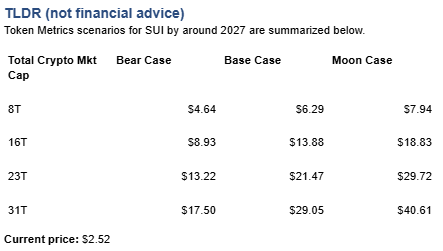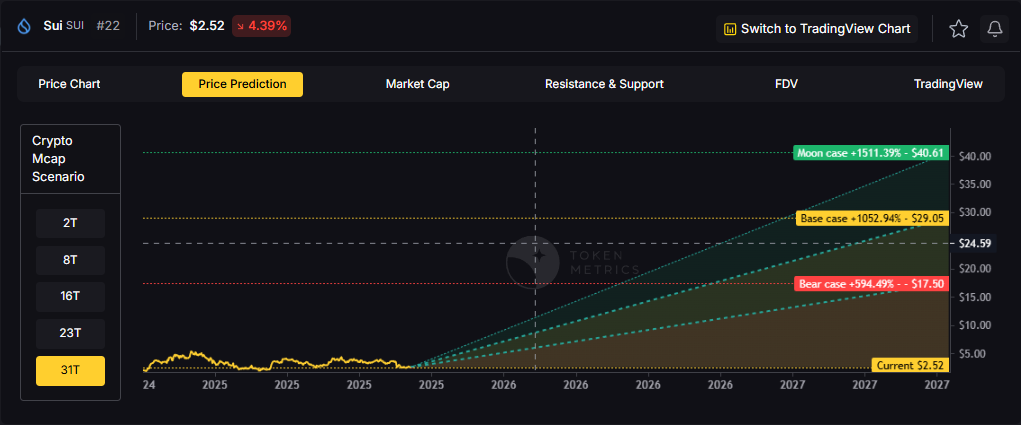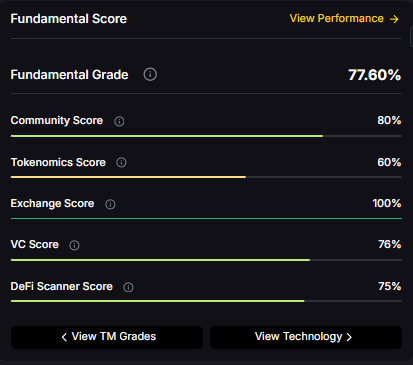The dream of passive income drives millions toward cryptocurrency—earning money while you sleep, building wealth automatically, achieving financial freedom without constant work. Yet most crypto "passive income" strategies require active management, constant monitoring, technical expertise, and significant time investment. They're anything but passive.
Token Metrics AI Indices deliver genuine passive income through systematic wealth accumulation requiring minimal ongoing effort. Once established, your crypto portfolio grows automatically through professional AI management, strategic rebalancing, and compound returns—all without your daily involvement or active trading.
This comprehensive guide explores how crypto indices create true passive income, compares index investing to other passive income strategies, reveals the mathematics of automated wealth compounding, and provides actionable frameworks for building substantial passive income streams through disciplined index allocation.
What True Passive Income Actually Means
Understanding genuine passive income requires distinguishing it from "active income disguised as passive" that dominates crypto discussions.
Active Income Disguised as Passive
Many crypto strategies marketed as "passive income" require substantial ongoing effort:
- Day Trading/Swing Trading: Requires constant market monitoring, analysis, and execution—full-time active work
- Yield Farming: Demands daily monitoring of APYs, moving capital between protocols, managing impermanent loss risks
- NFT Flipping: Requires researching projects, timing mints, managing listings, following trends constantly
- Staking on Volatile Assets: Needs continuous evaluation of lock-up risks, protocol security, and token price sustainability
- DeFi Protocol Management: Involves complex smart contract interactions, gas fee optimization, and continuous security monitoring
These strategies generate income but demand active participation—they're jobs, not passive income streams.
Characteristics of Genuine Passive Income
True passive income exhibits specific characteristics:
- Minimal Time Investment: Requires 1-2 hours monthly maximum after initial setup
- No Specialized Expertise: Accessible to anyone regardless of technical knowledge
- Automatic Execution: Operates without your constant involvement or decision-making
- Predictable Processes: Follows systematic approaches rather than requiring moment-to-moment judgment
- Scalable Without Additional Time: Can grow substantially without proportionally increasing time commitment
- Professional Management: Experts handle complexity on your behalf
Token Metrics indices meet all these criteria—once established, your wealth grows automatically through AI-powered management while you focus on other priorities.
How Crypto Indices Create Passive Income
Understanding the mechanisms generating passive returns through indices reveals why this approach delivers superior risk-adjusted income compared to alternatives.
Capital Appreciation Through Systematic Growth
The primary income source from crypto indices is capital appreciation—portfolio value increasing over time as cryptocurrency markets grow and AI optimization captures opportunities.
Unlike stocks requiring decades to double, crypto indices can deliver 50-200% annual returns during favorable market cycles. A $25,000 initial investment growing at 60% annually becomes $100,000 in three years and $400,000 in six years—substantial wealth creation requiring zero active trading.
This appreciation occurs passively through:
- AI selecting highest-probability opportunities across 6,000+ tokens
- Automatic rebalancing capturing profits from winners and accumulating losers at discounts
- Diversification spreading risk while maintaining upside exposure
- Professional risk management limiting catastrophic losses
You make no trading decisions. You don't research tokens. You don't time markets. The system handles everything while appreciation compounds automatically.
Compound Growth Acceleration
Passive income's true power emerges through compounding—returns generating additional returns in self-reinforcing cycles. Token Metrics indices amplify compounding through systematic profit capture and reinvestment.
When indices rebalance, profits from appreciating tokens are automatically reinvested into new opportunities. This mechanical reinvestment ensures all gains compound rather than sitting idle. Over years and decades, compounding creates extraordinary wealth accumulation.
Example: $10,000 growing at 40% annually with full reinvestment becomes $150,000 in seven years. Without reinvestment—if you withdrew gains annually—the same investment reaches only $38,000. Compounding creates an additional $112,000 in wealth automatically.
Dollar-Cost Averaging Enhancement
Adding regular contributions to index positions creates powerful dollar-cost averaging benefits that enhance passive returns. By investing fixed amounts regardless of market conditions, you automatically buy more tokens when prices are low and fewer when prices are high.
This systematic averaging removes timing pressure—you don't need to identify perfect entry points. Whether markets surge or crash, your regular contributions continue mechanically, building positions that appreciate over complete market cycles.
Combined with compound growth, dollar-cost averaging creates remarkable long-term wealth accumulation requiring minimal effort beyond initial automated contribution setup.
Tax-Efficient Growth Optimization
Token Metrics indices can be held in tax-advantaged retirement accounts where appreciation compounds tax-free (Roth IRA) or tax-deferred (Traditional IRA). This tax optimization dramatically accelerates wealth accumulation compared to taxable accounts.
In taxable accounts, annual rebalancing triggers capital gains taxes that reduce compounding power. In retirement accounts, all gains compound without tax drag—a significant passive income enhancement requiring only initial account setup.
Comparing Index Passive Income to Alternatives
Understanding how index-based passive income compares to other strategies reveals relative advantages.
Vs. Staking/Yield Farming: While staking offers 5-20% APY, it involves token price risk (10% yield means nothing if price drops 50%), lock-up periods preventing selling during crashes, impermanent loss, protocol risks, and constant management overhead. Index capital appreciation typically exceeds staking yields by 40+ percentage points while maintaining complete liquidity.
Vs. Real Estate: Real estate requires $50,000-$500,000+ minimums, involves management burdens despite property managers, suffers from illiquidity (months to sell), concentrates wealth geographically, and carries leverage risks. Indices require minimal capital, zero management, complete liquidity, global diversification, and no leverage risks.
Vs. Dividend Stocks: Dividend yields of 2-4% and appreciation of 6-8% annually pale against crypto potential. Dividends trigger immediate taxation reducing after-tax returns. Crypto indices offer dramatically higher return potential with tax-efficient compounding.
Vs. Bitcoin/Ethereum Only: Concentrated two-asset holdings sacrifice diversification, miss altcoin opportunities, lack rebalancing benefits, and forego professional management. Indices provide superior risk-adjusted returns with equal passivity.
The Mathematics of Automated Wealth Building
Understanding how small initial investments and regular contributions compound into substantial wealth over time makes passive income potential concrete rather than abstract.
Starting Small: The Power of Consistency
You don't need large capital to begin building meaningful passive income. Small amounts invested consistently compound into substantial wealth through time and returns.
Scenario 1: Modest Beginning
- Initial investment: $1,000
- Monthly contribution: $250
- Average annual return: 50%
- Time horizon: 10 years
- Ending value: $486,000
This scenario transforms $31,000 in total contributions into nearly half a million through compound growth—passive income requiring only initial setup and automated monthly contributions.
Scenario 2: Aggressive Accumulation
- Initial investment: $5,000
- Monthly contribution: $500
- Average annual return: 50%
- Time horizon: 10 years
- Ending value: $972,000
Nearly $1 million from $65,000 in contributions—extraordinary passive wealth creation through systematic index investing.
The Impact of Return Variability
Real returns vary annually—bull markets deliver 100-300% returns while bear markets create 50-80% drawdowns. However, averaging across complete cycles, conservative crypto indices historically achieve 30-60% annualized returns.
- Even at conservative 30% annual average:
- $10,000 initial + $300 monthly for 15 years = $1.1 million
- $25,000 initial + $500 monthly for 15 years = $2.8 million
These projections assume no income from your job increases, which is unrealistic. As your career progresses and income grows, contribution amounts can increase proportionally, accelerating wealth accumulation further.
Retirement Income Generation
Once accumulated, substantial crypto index holdings generate retirement income through systematic withdrawal strategies.
If you accumulate $2 million in crypto indices by age 60, withdrawing 4% annually provides $80,000 passive income while preserving principal. If crypto continues appreciating even modestly at 15% annually, your portfolio grows despite withdrawals, providing inflation-protected lifetime income.
This passive income stream requires no active work—automated monthly withdrawals provide cash flow while remaining capital compounds through continued AI management.
Building Your Passive Income System
Creating effective passive income through crypto indices requires systematic implementation across several phases.
Phase 1: Foundation Setup (Month 1)
- Open Token Metrics account and explore available indices
- Determine appropriate total crypto allocation based on age, risk tolerance, and financial situation
- Select specific indices matching your risk profile (conservative, balanced, aggressive)
- Open exchange accounts and complete verification processes
- Link bank accounts for funding transfers
- Consider opening self-directed IRA for tax-advantaged growth
Complete this foundation work once—all subsequent wealth building occurs automatically.
Phase 2: Automation Implementation (Month 2)
- Set up automatic recurring bank transfers to exchange accounts
- Configure automatic index purchases on predetermined schedules (weekly, bi-weekly, or monthly)
- Enable automatic rebalancing following Token Metrics recommendations
- Set up portfolio tracking and optional performance alerts
- Document your strategy and rules in writing for future reference
After automation setup, your system operates independently requiring minimal intervention.
Phase 3: Optimization and Scaling (Months 3-12)
- Monitor system monthly to ensure automation functions correctly
- Increase contribution amounts as income grows throughout your career
- Rebalance between indices quarterly based on Token Metrics guidance
- Take advantage of market crashes by adding lump sums opportunistically
- Review and adjust tax strategies annually with professional guidance
Even during optimization phase, time commitment remains minimal—1-2 hours monthly maximum.
Phase 4: Wealth Preservation and Distribution (Years 10+)
- Gradually shift allocation toward conservative indices as wealth accumulates
- Implement systematic profit-taking during euphoric bull markets
- Develop withdrawal strategy for retirement income needs
- Consider estate planning for accumulated wealth transfer
- Maintain disciplined approach through all market conditions
Throughout all phases, your involvement remains minimal while wealth compounds automatically through professional AI management.
Maximizing Passive Income Through Strategic Allocation
Optimizing passive income requires strategic decisions about allocation, risk management, and contribution timing.
Allocation Balance: Higher returns come with higher volatility. Conservative approach uses 70% conservative/20% balanced/10% aggressive indices. Moderate uses 50/30/20 split. Aggressive uses 30/30/40 split. All remain completely passive from management perspective.
Contribution Timing: Maintain regular automated contributions always, but keep 10-20% dry powder in stablecoins for crisis deployment during 30%+ market crashes. These fear-driven purchases generate outsized returns.
Tax Location Optimization: Roth IRA provides tax-free growth ideal for aggressive indices. Traditional IRA offers tax-deferred growth suitable for conservative indices. Taxable accounts provide flexibility but trigger annual rebalancing taxes. This optimization happens once but compounds into substantial savings over decades.
Common Passive Income Mistakes to Avoid
Even with automated systems, investors make predictable mistakes that undermine passive income goals.
- Insufficient Automation: Failing to fully automate contributions and rebalancing introduces friction preventing consistent execution
- Excessive Monitoring: Checking portfolio daily or weekly increases anxiety without improving results—monthly reviews suffice
- Abandoning Strategy During Drawdowns: Selling during bear markets destroys passive income system's effectiveness—maintain discipline through downturns
- Chasing Performance: Constantly switching between indices based on recent performance undermines long-term compounding
- Withdrawing Gains Prematurely: Taking profits during accumulation phase prevents compounding—let gains reinvest automatically
- Under-Contributing Relative to Income: Failing to increase contributions as career income grows limits wealth accumulation unnecessarily
- Neglecting Tax Optimization: Holding crypto in taxable accounts when retirement accounts available costs substantial long-term returns
Conclusion: The Path to Financial Freedom
True passive income through crypto indices isn't mythical—it's mathematically achievable through systematic implementation and patient execution. Token Metrics provides the professional AI management, diversification, and optimization infrastructure transforming crypto from speculation into genuine passive wealth building.
The beauty of this approach is simplicity: establish system once, contribute consistently, trust professional management, and let compound growth work its magic over years and decades. No day trading. No constant monitoring. No technical expertise required. Just disciplined, automated wealth accumulation.
Your action determines outcomes. Those who begin today, implement systematic contributions, and maintain discipline through market cycles build substantial passive income streams funding financial independence. Those who delay, overthink, or abandon strategy during volatility watch opportunities pass without capturing benefits.
Token Metrics indices eliminate complexity and emotion from crypto investing, leaving only systematic wealth accumulation. The technology works. The mathematics favor consistent long-term investors. The only question is whether you'll begin building your passive income system today or postpone financial freedom indefinitely.
Start your 7-day free trial and take the first step toward true passive income through automated, professional crypto index investing. Your future self will thank you for the decision you make today.
Frequently Asked Questions



.svg)


.png)




%201.svg)
%201.svg)


%201.svg)

















.svg)




.png)